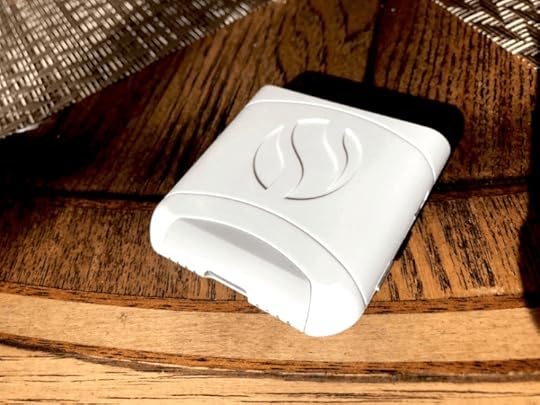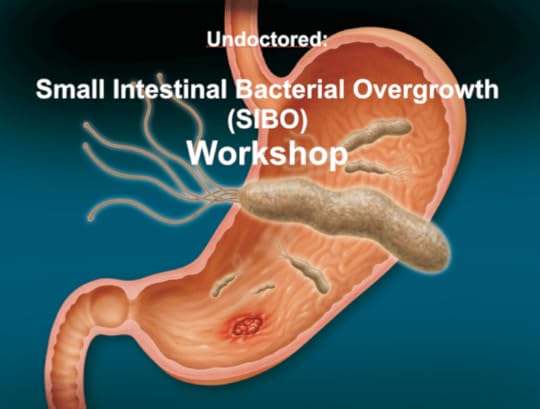William Davis's Blog: Dr. Davis Infinite Health Blog, page 55
February 5, 2019
How to use the new AIRE device

There’s a very clever, elegant new consumer health testing device called AIRE made by a company called FoodMarble. The device (pictured above) measures hydrogen gas, H2, in the breath, the same as formal H2 testing used to diagnose small intestinal bacterial overgrowth, SIBO.
Formal H2 breath testing is a hassle. There’s a day-before prep, you drink a sugar solution (lactulose or glucose), then collect breath samples every 15 minutes for 3 hours, then mail the package to a lab. If obtained directly without a doctor, each single-use test kit (glucose only) costs $149. If obtained through a doctor, then additional charges are typically added, especially if the testing is done in a lab or office. Each test kit is useful for only one round of tests. If you want to verify, for instance, that SIBO has been eradicated after a course of antibiotics, then you have to purchase another test kit and go through the process again. The same is true when assessing for all-too-common recurrences: another $149 test kit, another round of testing.
The AIRE device is therefore a game-changer, as it is reusable over and over again. At $159 per device, it can save a lot money over time, as well as cut down considerably on the hassle. It is exceptionally easy to use: turn the device on by pushing a button, open the app on your smartphone. It takes about two minutes for the device to warm-up, then it tells you to blow into the device for about 5 seconds and yields a 0-10 H2 reading within a few seconds.
The real usefulness of this device, however, is to generate a time-course of H2 release. In other words, perform a test prior to eating, consume food containing prebiotic fiber, then test again every 15-30 minutes for 3 hours; stop if a positive reading is obtained. In other words, you are trying to assess whether prebiotic fibers are converted to H2 gas by bacteria high up in the stomach, duodenum, jejunum, or ileum. If you test positive, you have SIBO. The AIRE device is also useful for assessing response to a course of treatment and to assess down the line for recurrences.
As elegant as the device is, there a few downsides:
The information provided with the device describe this technology as useful only to identify intolerance to FODMAPs foods. In other words, if you eat an apple and 30 minutes later you test H2-positive, FoodMarble says stop eating apples. You can see the folly in this and with all FODMAP conversations: It does not address the cause, i.e., SIBO or severe dysbiosis. This is why I tell people that a low-FODMAPS diet is nothing more than a symptom reducing maneuver, but does not correct anything, restore a healthy microbiome, or remove a potent source of inflammation (SIBO). (I don’t know if the company neglected any mention of SIBO to avoid tangling with the FDA and FTC, who give companies a hard time if they claim to diagnose or treat any health conditions. But I suspect they may not fully appreciate the implications of their device.) Follow the directions provided on how to use the device, but ignore the advice on avoiding FODMAPs.
This device is for the personal use of one person—The mouthpiece is not disposable, but can be wiped off with a moist cloth or paper towel. The company urges you to not use alcohol because it can damage the mouthpiece. You can share the device, of course, with someone you are intimate with, but it’s probably a bad idea to share with, say, coworkers or neighbors. In effect, one device for each person who wants to engage in testing.
I asked the company if they would share their data correlating their 0-10 H2 scale with formal H2 testing in parts per million H2. As I expected, they said no, claiming that it is proprietary. (This happens virtually every time we ask a company to share validation or reproducibility data: no, it’s proprietary. So we either perform the correlative testing ourselves or take FoodMarble’s word for their semi-quantitative scale.
Nonetheless, the device is a major step forward for managing SIBO, just as fingerstick blood sugar testing enormously empowered people in managing, and now reversing, type 2 diabetes. It is especially helpful for those of us self-managing SIBO in a world in which physicians do not keep up with issues in health unless they yield rich revenue returns. We shall be discussing the use of the AIRE device in more detail and how to put it to use as part of your health-restoration program in our Undoctored Inner Circle.
The post How to use the new AIRE device appeared first on Dr. William Davis.
February 4, 2019
I leg press 415 pounds . . . many times

While the human study has not yet been performed, an experimental model has demonstrated that senile loss of muscle (“sarcopenia”) is dramatically reversed by oxytocin. Atrophied muscle cells in elderly mice plump up and grow, making old muscle virtually indistinguishable from young muscle.
I’ve previously discussed how aging in humans is associated with loss of 35-50% of total muscle mass, a phenomenon readily visible by looking at most people in their 70s and 80s. And we should view muscle mass and strength as biomarkers of aging, as greater muscle and strength are associated with better agility, less falls, fewer injuries, greater bone mass, higher levels of growth hormone, and other markers of youthfulness.
Does the restoration of muscle from consuming our oxytocin-boosting L. reuteri yogurt occur in humans? I believe it does. I’ve now witnessed this in a number of people, including myself.
I personally gained 13 pounds of muscle over a 3 week period while going to the gym twice per week for a brief 15-20 minute strength-training session. I also saw my strength increase. While I used to handle 130 pounds for 8-10 repetitions on the lat pulldown machine, for instance, I now handle 200 pounds for the same number of repetitions. I bench press 170 pounds, leg press 415 pounds (that’s as high as the machine goes, so I go for higher repetitions, as I no longer have the patience to stack plates on a barbell), two-arm deltoid row 190 pounds, all for high repetitions. I’m 61 years old.
I’m not boasting. I am simply illustrating the breathtaking restoration of muscle mass and strength that results from the oxytocin burst we obtain from the L. reuteri yogurt. The increase in muscle and strength has made climbing stairs a snap, it has made shoveling snow or raking leaves child’s play.
The increase in muscle is much more dramatic if you engage in some form of strength training. Gains appear to be minimal without it. I believe that muscle/strength restoration is part of the panel of age-reversing effects the L. reuteri yogurt provides, effects that include thicker skin, increased dermal collagen, accelerated healing, and increased libido.
The post I leg press 415 pounds . . . many times appeared first on Dr. William Davis.
February 2, 2019
The lowdown on FODMAPs

A low-FODMAPs diet, the abbreviation for fermentable oligosaccharides, disaccharides, monosaccharides, and polyols, has been shown to reduce symptoms of irritable bowel syndrome, IBS, in studies conducted at Monash University in Australia. It is a diet crafted to remove fructans, fructooligosaccharides (inulin), galactooligosaccharides, lactose, fructose, sorbitol, and mannitol that human bowel flora metabolize and many need to survive. A low-FODMAPS diet is therefore designed to starve bowel flora that metabolize such sugars. You can find a listing of FODMAPS eliminated and permissible foods here.
Does it work to reduce symptoms of IBS? Yes, it does. a FODMAPs-reduced diet reduces the bloating, abdominal discomfort, and unpredictable bowel urgency and diarrhea characteristic of IBS. The relief provided can be considerable.
Recall that most IBS is really SIBO. In other words, efforts to reduce diarrhea, cramping, and urgency typically ignore the cause: unhealthy changes in bowel flora that have ascended up from the colon and into the ileum, jejunum, duodenum, and stomach.
But the FODMAPs diet has triggered considerable confusion on what it accomplishes and what it does not accomplish, some even advocating it as a panacea. And is it good for you? Does it improve health? And what is the effect on the microbiome? Is it really an answer for health issues? Does reducing the symptoms of IBS lead to better bowel and overall health long-term?
I believe it helps to view a FODMAPs-reduced diet as nothing more than a symptom-reducing maneuver. By depriving bowel flora—both unhealthy undesirable species such as E. coli, Campylobacter, and Shigella, as well as desirable species such as Lactobacillus, Bifidobacteria, Akkermansia, and selected Clostridia—of necessary nutrients, bacterial counts in the gastrointestinal tract drop. With their reduced numbers, toxic components such as lipopolysaccharide, LPS, released with the death of undesirable microorganisms, is reduced, leading to less intestinal inflammation, less body-wide inflammation. FODMAPs reduction can therefore lead to reduced bloating, abdominal discomfort, and diarrhea that may or may not return upon resumption of FODMAPS consumption after several weeks to months of engaging in the diet.
But it is important to recognize that a low-FODMAPs diet also introduces undesirable changes in the microbiome:
Reduces bacterial species diversity—Species diversity is a consistent marker of better health.
Reduces Bifidobacteria substantially–Bifidobacteria confer a number of important health benefits.
Reduces Clostridia species that produce butyrate—Butyrate is a mediator of a number of important health benefits.
Most important of all, a low-FODMAPs diet does nothing to restore a healthy microbiome, certainly not if you begin with severe dysbiosis, SIBO, or intestinal fungal overgrowth. Yes, it reduces the numbers of pathogenic bacteria but does not restore healthy balance of microorganisms. A diet temporarily deprived in FODMAPs cannot yield the increased butyrate required for intestinal healing. It does not restore the healthy balance of Akkermansia that increases the production of protective mucous. It does not replenish or seed the intestines with healthy species such as (our favorite species) Lactobacillus reuteri.
A FODMAP-elimination effort is therefore useful to reduce symptoms in IBS, SIBO, and dysbiosis, much like taking an opiate can relieve a headache from having a brain tumor—but symptom relief is not the same as disease reversal. So should you choose to follow a low-FODMAP lifestyle, recognize that it is only a symptom-reducing effort but does little to nothing to restore a healthy microbiome. It takes additional efforts to accomplish that, efforts such as supplementing curcumin to rebuild the integrity of the intestinal barrier, efforts to increase Akkermansia populations, and efforts to reduce fungal populations.
The post The lowdown on FODMAPs appeared first on Dr. William Davis.
February 1, 2019
Ten reasons to NEVER eat gluten-free processed foods
 .
.It saddens me: As popular as the Wheat Belly books and lifestyle have been, there are still millions of people who say things like “Oh, that Wheat Belly thing is just about being gluten-free.” They couldn’t be more wrong and have clearly not read any of the books.
Yes, you can be gluten-free and consume foods that naturally have no gluten, gliadin, wheat germ agglutinin, amylopectin A, phytates, and the rest of the toxic components contained in wheat and related grains. You can eat apples, bacon, eggs, and salmon that are naturally gluten-free. You can drink water or tea that is gluten-free. No problems here.
But turn to the thousands of processed gluten-free foods made with cornstarch, rice flour, tapioca starch, and potato starch and all sorts of awful things happen—despite the double-digit growth of this industry that has swelled to many billions of dollars per year. You won’t, of course, hear any of this from companies like Udi’s and Schar who make a lot of money selling their products. And it doesn’t help that there are dozens of cookbooks written by authors who have no understanding of the damaging message they are propagating.
So what happens when you are misled into thinking that processed gluten-free foods are healthy replacements for wheat and grains? Here are 10 reasons:
Gluten-free foods raise blood sugar higher than all other foods—Higher than wheat, higher than sugar, higher than candy bars or jelly beans. Just ask anyone who tracks fingers stick blood sugars 30-60 minutes after consuming something gluten-free.
Gluten-free foods cause insulin resistance—High blood sugar provokes high blood insulin that, in turn, leads to insulin resistance followed by type 2 diabetes.
Gluten-free foods can reactivate celiac disease and gluten-intolerance reactions—The cornstarch, for instance, included in many gluten-free processed foods contains residues of the corn protein, zein. While zein is not gluten or gliadin, it overlaps in structure with gliadin and can thereby reactivate many of the same responses. (Gliadin and zein are members of a class of proteins called prolamins by agricultural scientists—they are closely related.) Likewise, rice flour contains residues of wheat germ agglutinin that is toxic even in small amounts to the human gastrointestinal tract.
Gluten-free foods provoke formation of small LDL particles—Small LDL particles—prone to oxidation, glycation, last 5-7 days rather than the 24 hours of large LDL particles, adherent to artery walls, highly inflammatory within artery walls—are the real cause for heart disease, not cholesterol. (“Cholesterol” is Big Pharma’s kindergarten version of how heart disease is caused, a profitable deception.) Gluten-free foods provoke small LDL particle formation extravagantly. Gluten-free foods thereby are prominent causes of heart attack and heart disease.
Gluten-free foods send fasting triglycerides through the roof—The rapidly-digested carbohydrate/sugars of gluten-free foods provoke a liver process called de novo lipogenesis that converts sugar to triglycerides that are released into the bloodstream. The increase in blood triglycerides is the first step in yielding small LDL particles and thereby increases heart disease risk.
Gluten-free foods amplify postprandial lipoprotein abnormalities—After you consume, say, a sandwich made with gluten-free flours, there is a flood of digestive byproducts that enter the blood stream as VLDL particles and chylomicrons. Because of the high carb/sugar content of gluten-free foods, there is an enormous surge of these particles after a gluten-free containing meal. It’s this period when most heart disease is caused, i.e., in the after-meal or postprandial period.
Gluten-free foods cause fatty liver—The same de novo lipogenesis in the liver that causes blood triglycerides to skyrocket with gluten-free foods causes some of the triglycerides to become trapped in the liver. Trapped triglycerides accumulate, leading to fatty liver that, if not reversed, leads to cirrhosis and liver failure over time.
Gluten-free foods alter bowel flora—Just as putting out bread crumbs makes the ducks follow you, ingesting gluten-free carbs/sugars “invites” unhealthy bacterial species to ascend up the intestinal tract, a phenomenon that leads to small intestinal bacterial overgrowth, SIBO, that, in turn, increases risk for autoimmune conditions, fibromyalgia, irritable bowel syndrome, diverticular disease, and colon cancer.
Gluten-free foods cause tooth decay—Just as the amylopectin carbohydrate of wheat and grains are extravagant contributors to dental decay and gingivitis, gluten-free foods do likewise due to their high carb/sugar content.
Gluten-free foods accelerate aging—Readers of the original Wheat Belly book know that whenever blood sugar goes up, irreversible reactions occur in the proteins of the body, a process called glycation. Glycated proteins become useless or dysfunctional. This is how cartilage proteins become glycated, causing cartilage to become brittle, then erode, leading over time to bone-on-bone arthritis. This is how the proteins of the lenses of the eyes become opaque and lead to cataracts. There are hundreds of other proteins that become glycated with the high blood sugars that occur after consuming gluten-free foods. The sum total effect? Accelerated aging.
Now I could go on and list a number of other adverse consequences that develop when you make the mistake of consuming gluten-free processed foods. Yes, you can be gluten-free. But don’t fall for the awful products made by the gluten-free processed food industry.
The post Ten reasons to NEVER eat gluten-free processed foods appeared first on Dr. William Davis.
January 31, 2019
SIBO Workshop: A 2-hour in-depth exploration of SIBO

Join us Wednesday evening, February 6th, at 8 pm EST/ 7 pm CST/6 pm MT/5 pm PT for my Undoctored SIBO Workshop: A 2-hour in-depth exploration of SIBO that I shall present via live video broadcast. The cost to attend is $55. (I will also be giving a SIBO Workshop for Undoctored Inner Circle members on Tuesday, February 5th at the same time slot.)
An unprecedented number of people now have small intestinal bacterial overgrowth, SIBO, an intestinal condition that has reached epidemic proportions. SIBO causes or worsens numerous health conditions such as fibromyalgia, irritable bowel syndrome, ulcerative colitis, and Crohn’s disease. If you have any of these conditions or have diabetes (type 1 or 2), an autoimmune condition, unexplained skin rashes, food intolerances, or fatigue, SIBO is something you should be aware of and, if uncorrected, can lead to irreversible health problems such as diverticular disease and colon cancer—it is well worth identifying, then correcting.
Problem: Because the science is so recent, the majority of doctors, even gastrointestinal specialists. remain in the dark about SIBO. But most people can take the reins on their own with impressive results.
I will discuss why recognizing SIBO is so crucial for health, how to identify whether you or someone close to you has it, how to manage (even without the doctor involved), and how to prevent recurrences. We will end with a live interactive Q&A session.
I will also discuss:
Why formal testing is not always necessary
What herbal antibiotic regimens are effective and safe, which are not
The benefits of rebuilding the intestinal barrier
Steps you must take to prevent recurrences
A print version containing an extended discussion will also be provided.
The cost to attend the LIVE event with Dr. Davis is $55. Click on the Add to Cart button below to sign up, then click on the PayPal button to submit payment.
Your cart is emptyVisit The ShopClick PayPal button above to checkout.
The post SIBO Workshop: A 2-hour in-depth exploration of SIBO appeared first on Dr. William Davis.
January 30, 2019
Cream of mushroom soup with chives

Here’s a Wheat Belly favorite from the Wheat Belly 30-Minute Cookbook, perfect to warm you up during these below-zero days we’re experiencing.
This thick and creamy mushrooms soup makes a filling meal by itself or a substantial accompaniment to pork, chicken, or beef dishes. As written, this recipe is dairy-free. If dairy avoidance is not an issue for you, the olive oil can be substituted with butter, coconut milk substituted with cream, half-and-half, or whole milk. Regardless, using higher-fat coconut milk or dairy is the way we like it around here: full of healthy fats.
Prep time: 5 minutes Total time: 20 minutes
Makes 8 servings
2 tablespoons extra-virgin olive oil
1 medium yellow onion, finely chopped
2 cloves garlic, minced
16 ounces baby bella, cremini, or button mushrooms, chopped coarsely
1 teaspoon sea salt or to taste
1 teaspoon black pepper
3 cups chicken stock
12 ounces coconut milk (full-fat canned)
2 tablespoons chives, chopped
In large skillet over medium-high heat, heat olive oil. Sauté onions and garlic until onions translucent, then add mushrooms. Reduce heat to medium, add salt and pepper, and cover for several minutes until mushrooms softened.
Stir in chicken stock and coconut milk, cover and simmer for 3-5 minutes.
Ladle or pour mixture into blender and blend until smooth (in batches, if necessary). Serve topped with chopped chives.
The post Cream of mushroom soup with chives appeared first on Dr. William Davis.
January 29, 2019
The Next 10-Day Wheat Belly Grain Detox Challenge Begins February 13th!

Put it off no longer: We are planning our next Wheat Belly 10-Day Grain Detox Challenge that starts on Wednesday, February 13th. This is your opportunity to seize control over health and weight, maybe even turn the clock back 10 or 20 years, look and feel better, be freed of numerous, if not all, prescription drugs.
In addition to our Wheat Belly 10-Day Grain Detox Private Facebook page that provides videos, success stories, and plenty of feedback and answers to your questions, the next Detox Challenge will also include:
1) LIVE Facebook sessions with Dr. Davis and April Duval, our main Facebook page administrator. I will personally kick off the Detox Challenge on February 13th. And because April is herself an example of a fabulous Wheat Belly Detox success, she knows the ins and outs of this lifestyle like the back of her hand.
2) Free access to the Suggestic smartphone app for the first 7 days of the Detox— The Suggestic iPhone app helps you navigate the Wheat Belly Detox with even more recipes, daily suggested recipes, a restaurant locator to identify eating places consistent with our lifestyle with suggested menu items, and all personally customizable. It is your chance to get acquainted with the useful Suggestic app while helping you succeed on your Wheat Belly 10-Day Grain Detox.
Here’s what you do:
Visit wheatbelly.suggestic.com/challenge by February 13th
Sign up to get 7-day free access to my challenge on the Suggestic app
On Feb 13th, go to the app’s homepage and tap “start program” so we can start the challenge together!
Our goal: to help you succeed in turning around your life and health and achieve all your health goals including weight loss, getting off prescription medications, and turning back the clock 10 or 20 years.
Why the Detox Challenge?
Through my New York Times bestseller, Wheat Belly, millions of people learned how to reverse years of chronic health problems by removing wheat from their daily diets. But, after reading the original Wheat Belly or the Wheat Belly Total Health book, or even using the recipes from the Wheat Belly Cookbook and Wheat Belly 30-Minute Cookbook, people still said: “I’ve read the books, but I’m still not sure how to get started on this lifestyle.”
That’s why I wrote the Wheat Belly 10-Day Grain Detox and now help readers along in this Wheat Belly 10-Day Grain Detox CHALLENGE. This is the quickest, most assured way to get started on regaining magnificent health and slenderness by adopting the Wheat Belly lifestyle.
We are kicking off the next Wheat Belly 10-Day Grain Detox Challenge on Facebook LIVE on Day 1: Wednesday February 13th, 12pm EST/11 am CST/10 am MT/9 am PT. Come join us on the private Wheat Belly 10-Day Grain Detox Facebook page: https://www.facebook.com/groups/52751...
You will also be given free access to the Wheat Belly 10-Day Grain Detox Suggestic smartphone app for the first 7 days of the Detox!

The Wheat Belly 10-Day Grain Detox supplies you with carefully designed meal plans and delicious recipes to fully eliminate wheat and related grains in the shortest time possible. Perfect for those who may have fallen off the wagon or for newcomers who need a jump-start for weight loss, this new addition to the Wheat Belly phenomenon guides you through the complete 10-Day Detox experience. And we will kick off this next Challenge with a live Facebook session with Dr. Davis!
In addition to this quick-start program, I’ll teach you:
How to recognize and reduce wheat-withdrawal symptoms,
How to avoid common landmines that can sabotage success
How to use nutritional supplements to further advance weight loss and health benefits
The Wheat Belly 10-Day Grain Detox also includes:
Inspiring testimonials from people who have completed the program (and have now made grain-free eating a way of life)
Exciting new recipes to help get your entire family on board
To join the Detox Challenge:
Step 1
Get the book. And read it (at least the first 5 chapters).
Detox Challenge participants should be informed and active in order to get the most out of the challenge and private Facebook group. READING THE WHEAT BELLY DETOX BOOK IS REQUIRED TO PARTICIPATE. PLEASE DO NOT PARTICIPATE IF YOU HAVE NOT READ THE BOOK or else the conversations will not make sense and you will not enjoy full benefit. It is a very bad idea to try and piece the program together just from our conversations. (Note that the Wheat Belly Detox program is NOT laid out in the original Wheat Belly book.)
Amazon: http://amzn.to/1JqzMea
Barnes & Noble: http://bit.ly/wheatbelly10daygraindetox-bn
Indiebound: http://bit.ly/1KwcFTQ
Step 2
Come join the Private Facebook Group.
http://bit.ly/WheatBelly-PrivateFBGroup
Step 3
Head back to the Private Facebook Group starting Tuesday, February 12th (the day before the official start of the Challenge) and onwards for tips, videos, and discussions to help you get through your detox and reprogram your body for rapid weight loss and health. Dr. Davis and site administrator, April Duval, will be posting video instructions and answers to your questions.
The post The Next 10-Day Wheat Belly Grain Detox Challenge Begins February 13th! appeared first on Dr. William Davis.
January 28, 2019
Cracker Bowel: Why Grains are Toxic to the Human Gastrointestinal Tract
We are told to eat “healthy whole grains” to boost fiber intake, maintain bowel regularity and intestinal health–but the exact OPPOSITE is true. Wheat and grains, especially modern wheat and grains, contain an entire collection of bowel toxins.
Banish wheat and grains from your diet and you are on the path to recovering gastrointestinal health and freedom from dozens of common gastrointestinal conditions.
Transcript:
Hi everybody, Doctor William Davis here. I call this video “cracker bowel”, because wheat and grains are a collection of very potent bowel toxins. You know, it’s ironic isn’t it, that we’re told that we need to eat wheat and grains; need to include them at every meal; because they’re so good for bowel health; because of bran or fiber content, for instance.
Well, that’s true. You can get more cellulose fiber, like sawdust, by eating grains, but this idea that grains are necessary for bowel health is complete nonsense. In fact, the opposite is true. Wheat and grains, particularly modern wheat and grains, are a collection of very toxic compounds to your gastrointestinal tract.
For instance, the gliadin protein within gluten, besides triggering celiac disease, also directly damages the intestinal lining. That’s because, recall that we cannot break down, we can’t digest, the proteins in grains, because we don’t have the enzymes to do that. If you eat an egg, or a piece of bacon, or a hamburger, you break the proteins down in those foods into single amino acids. That’s how you’re supposed to digest proteins.
When you eat the proteins of grains, you either can’t digest them at all, or they’re broken down to pieces — not amino acids, but peptides — several amino acids long. We don’t have the enzymes to break down each bond between each amino acid. That’s how we get gliadin-derived opioid peptides, for instance, that cause appetite stimulation and mind effects. In this case, these small peptides are also toxic, directly toxic to the gastrointestinal lining.
We also are exposed to wheat germ agglutinin. It sounds like “gluten”, but it’s unrelated to gluten. It’s wheat germ uh-GLOO-tih-nin. It’s called agglutinin because it when it contacts blood, it causes it to clot, or agglutinate.
Wheat germ agglutinin is one of those proteins that is completely impervious to human digestion. So if it goes in here [points to mouth] it comes out the other end, intact. But in its course from top to bottom, it is highly toxic. It damages the villi, the little hairs that line intestinal tract, and are responsible for absorption of nutrients. It’s very destructive to those villi, and that can lead to inflammatory changes like colitis.
Wheat germ agglutinin is also very effective in blocking the hormone cholecystokinin (or we say CCK for short).
Screen text: CHOLECYSTOKININ (CCK)
CCK is a hormone released when you eat food, and food contacts the duodenum, the duodenum releases this hormone, CCK. CCK causes two things to happen. It causes your gallbladder to squirt out bile to help modify fats, and it causes your pancreas to release digestive enzymes. Wheat germ agglutinin is a very potent blocker of CCK.
It means that your digestion is impaired. That can lead to acid reflux, stomach upset, heartburn, and over time, disrupts bowel flora, because you’re not fully digesting food. It can also lead to gallstones, because there’s bile stasis. When you have bile stasis, there’s crystallization in the gall bladder. That’s what leads to gallstones over time.
There are also unhealthy changes provoked in bowel flora, especially fungal overgrowth; fungi like Canada albicans.
Screen text: INTESTINAL FUNGAL OVERGROWTH
This is a big problem — a growing problem. It’s responsible for problems like recurrent skin rashes, fatigue, gastrointestinal problems, and can lead to other forms of dysbiosis like SIBO
Screen text: SMALL INTESTINAL BACTERIAL OVERGROWTH (SIBO)
once again, disrupt bowel flora, but especially fungal overgrowth.
Those gliadin-derived peptides, that act like opiates? Well, you know that opioids, or opiates, cause constipation. So the opioid peptides that come from gliadin are very constipating. What we’re told to consume (the brans in grains, for regularity) the opposite is often true — because the opioid peptides that derive from gliadin cause constipation.
Some of the worst constipation you’ll ever see is called obstipation. These poor people can move their bowels maybe every once or every 2 or 3 weeks. It’s a horrible, horrible situation, that responds only to enemas — repeated enemas. It doesn’t even respond to laxatives. Obstipation, severe constipation, goes away within days of stopping all grains. That’s because you’re getting rid of opioid peptides.
Lastly, there’s a collection of allergens in grains that can be responsible for a variety of gastrointestinal symptoms like stomach upset, acid reflux, etc.
This notion that you must eat grains for gastrointestinal health is a complete fairy tale. In fact, the opposite is true. That’s why if you follow along my Wheat Belly and Undoctored conversations, you see, every day, there’s a flood of comments from people who’ve been freed of acid reflux, esophagitis, reflux esophagitis, stomach problems, poor digestion, ulcerative colitis, Crohn’s disease, irritable bowel syndrome symptoms. A wonderful start to a gastrointestinal health program is to eat no wheat and no grains.
The post Cracker Bowel: Why Grains are Toxic to the Human Gastrointestinal Tract appeared first on Dr. William Davis.
January 27, 2019
Bagel Brain: What Wheat and Grains Do to the Brain
You know that raisin bagel or bowl of bran cereal you have every morning, or the plate of pasta or spaghetti you have for dinner? Each and every serving erodes the health of your brain. Some of the effects are reversible, while others are cumulative and irreversible.
But understand the concepts behind living the Wheat Belly wheat/grain-free lifestyle and you are enormously empowered in regaining control over health, weight, and youthfulness.
Transcript:
Hi everybody, Doctor William Davis here. Why do I call this Bagel Brain? Well, a number of reasons — consumption of modern wheat and closely-related grains have a whole multitude of effects on the human brain — undesirable effects. Let’s talk about them.
You can group the effects that wheat and grains have on the brain into reversible causes (that is, temporary causes, that go away after you stop consuming them), and then there are either poorly reversible or partially reversible, or even irreversible changes in the brain — diseases of the brain that you cannot undo, or only can partially undo.
Screen text:
1. Reversible
2. Partially reversible or irreversible
Let’s talk about the reversible changes. The reversible changes in the brain are due mostly to the gliadin protein and gliadin-derived opioid peptides. Recall, that wheat and grains are the seeds of grasses, and humans simply lack the enzymatic machinery to break down the components of seeds of grasses. That means many of the proteins are either indigestible, like wheat germ agglutinin (completely impervious to human digestion), or only partially digestible (like the gliadin protein within gluten). The gliadin is broken down into four- or five-amino-acid-long peptides (pieces), unlike, say, the proteins of a pork chop, steak, hamburger, eggs. Those proteins are broken down to single amino acids for absorption.
Well, when you eat the gliadin protein of wheat,and related proteins in other grains (like the secalin in rye, hordein in barley, zein in corn), you break them down into pieces, not to amino acids. These 4- or 5-amino-acid-long peptides are able to cross, into the brain, through the so-called blood-brain-barrier, and bind to the opioid receptors in the human brain. What does that do?
Well, in people who have paranoid schizophrenia, it causes paranoia — worsens paranoia, and causes them to hear voices — auditory hallucinations. In children with ADHD or autistic spectrum disorder, it triggers behavioral outbursts, and it abbreviates their attention span. In people who are prone to depression, it causes depression. In people who are prone to bipolar illness, it can trigger the manic phase. In people who are prone to bulimia, or binge eating disorder, it can trigger 24-hour-a-day food obsession.
How about you and me, who might not have those conditions? It “only” triggers appetite. So people who consume grains are prompted to consume around 400-800 more calories per person per day, though sometimes it can be much more, like 1500 calories per day. In other words, gliadin-derived opioid peptides, from the partial digestion of wheat and related grains, are appetite stimulants. That’s why people who consume grains will pile their plates high with food, then go back for seconds, or eating at a buffet, and go back-and-forth back-and-forth, because they can’t get enough. These are people who eat a big plate of pasta — they’re so full their stomach hurts — but they’re still hungry.
That all goes away, by the way, when we’re wheat- and grain-free. So those are the reversible changes, largely due to the gliadin-derived opioid peptides.
Now there’s also a collection of irreversible, or only partially-reversible changes, such as cerebellar ataxia. That’s a condition where the cerebellum, in the back of the brain, that controls functions like bladder control, bowel control, and balance — atrophies. It kind of degrades and it gets damaged, and it atrophies. On an MRI or a CAT scan you’ll see that the cerebellum is shrunken. This results in people loosing balance. They fall. They stumble very readily. They lose control of their bladder and bowels. And they eventually, within a few years, die. That’s a disease of wheat and grain consumption.
It is only partially reversible, because autoimmune conditions of the brain are difficult to turn around, and the brain’s not very good at healing. Typically what happens is, that someone who identifies with cerebellar ataxia from the gliadin protein of wheat and related grains, you stop wheat and grains, and it typically stops getting worse, and you can get partial remission. I have seen cases of complete remission, but most commonly, partial remission. So the key, with cerebellar ataxia, is: identify it as early as possible.
Seizures, can be caused by wheat and grains. The most common form of seizure is what’s called temporal lobe seizures. We often see a collection of calcium in the temporal lobe, by a CAT scan or an MRI. It’s more common in teenagers. When you stop wheat and grains, in this case, you can reverse it. It may take some weeks to months, but those seizures typically stop. Wheat and grain consumption less commonly causes grand mal seizures, also. I have seen a handful of cases where grand mal seizures miraculously stopped, with halting consumption of wheat and grains.
Lastly dementia: wheat and grains contribute to dementia in a variety of ways. Of the two most important ways is something called gluten encephalopathy. This is an autoimmune process, that’s rapidly fatal. The onset of memory impairment (dementia), to death, is on average, two years — a very rapid, aggressive form of dementia. That’s gluten encephalopathy.
A much more common form of dementia is triggered by the high blood sugars, and the body-wide inflammation, triggered by the inflammatory components in grains. The high blood glucose, for instance, causes glycation, that is, glucose modification of proteins, that is irreversible. The various proteins in the brain become glycated. When proteins become glycated, the become ineffective. They become, essentially, debris, and it causes debris accumulation in the brain.
Also, you get insulin resistance in the brain. That’s why you hear people call dementia Type 3 Diabetes.Wheat and grain consumption raises blood sugar, raises insulin, over time generates insulin resistance, you grow visceral fat (a wheat belly), and the increasing insulin resistance, the glycation, all contribute to dementia. Those issues are largely irreversible. Once again, the key, just like cerebellar ataxia, is to go wheat- and grain-free as early as possible in life, so these irreversible changes don’t occur.
Bottom line: wheat and grains, contrary to popular opinion and conventional dietary advice, are awful for your health. In this case, they damage your brain. They have transient (or reversible) effects and they have irreversible effects. The key is don’t eat bagels, waffles, pancakes — unless you re-create them, using some of the Wheat Belly type recipes, and safe replacement ingredients, like almond flour, ground golden flaxseed, coconut flour, and natural non-caloric sweeteners.
The post Bagel Brain: What Wheat and Grains Do to the Brain appeared first on Dr. William Davis.
January 23, 2019
Wheat Belly: Faces tell the story

Looking back through the many before/after success photos posted here over the years on the Wheat Belly Blog and the Wheat Belly Facebook page, you can’t help but be stunned by the dramatic contrasts in facial appearance that develop with removal of the inflammation provoked by wheat and grains.
Ann is the photo at the top. While she described substantial health benefits, you can tell that a lot of changes have occurred just from her photograph.
“During my pre-Wheat Belly lifestyle, my face was puffy, I was heavier all over, my hair was thinning and brittle, I was tired all the time and my joints were starting to ache. I feel great now. My hair is soft, thicker and longer, no more puffy face, no more sore joints. Now I can hardly wait to wake up in the morning to go for a walk!”
Gwen’s several month before/after:

Ann’s change in appearance was dramatic even though she lost only 3 pounds, reflecting the marked reversal of inflammation with the Wheat Belly lifestyle:

It’s something I witness every day: Yes, people lose weight. But the change in appearance, especially that of the face, is out of proportion to the weight lost. Just look at the eyes alone: less puffy, larger—we’ve seen this effect countless times. It reflects the loss of facial skin edema and inflammation, an effect that occurs body-wide but is most evident on the face.
The Wheat Belly lifestyle is not just another low-carb diet; it is a rejection of the inflammatory, health-crippling effects of wheat and grains.
The post Wheat Belly: Faces tell the story appeared first on Dr. William Davis.
Dr. Davis Infinite Health Blog
Recognize that this i The insights and strategies you can learn about in Dr. Davis' Infinite Health Blog are those that you can put to work to regain magnificent health, slenderness, and youthfulness.
Recognize that this is NOT what your doctor or the healthcare system provides, as they are mostly interested in dispensing pharmaceuticals and procedures to generate revenues. The healthcare INDUSTRY is not concerned with health--you must therefore take the reins yourself.
Dr. Davis focuses on:
--Real, powerful nutritional strategies
--Addresing nutrient deficiencies unique to modern lifestyles
--Deep insights into rebuilding the microbiome disrupted by so many modern factors
Follow Dr. Davis here and on social media and you can witness the extraordinary successes people enjoy on his programs. ...more
- William Davis's profile
- 159 followers



